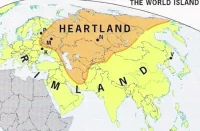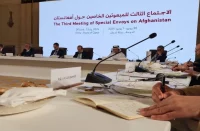Nataliya Bulygina (Russia)
That difficult security situation in modern-day Afghanistan is a key problem for the development of the country, maintenance of a stable social and economic system and protection of the populace against existing threats—both militant attacks and natural disasters, which are difficult to address without assuring order in the region.
One major step taken by the Afghan government to solve that problem is the reconciliation and reintegration program. The results of that strategy can primarily be seen in the establishment of state organizations to reintegrate former insurgents, the movement of militants to the government’s side and confirmed cases of attacks by former comrades on members of the armed opposition who make peace with the government. In this article we will examine the performance of the reconciliation program from an ideological perspective by analyzing a sample of current insurgent propaganda.
A message from Taliban spiritual leader Mohammed Omar denies that reconciliation with Afghanistan’s official government is a possibility. It was first posted September 8 on several websites linked to the Taliban movement just before the major religious holiday Eid al-Fitr. Nevertheless, analysis of the text suggests that President Hamid Karzai’s strategy of reconciliation with the armed opposition has influenced Omar’s rhetoric. Omar’s message is also imbued with the pathos of reconciliation—but of reconciliation between the various mujahedeen factions, including the return of former militants to the opposition’s ranks. Like the Afghan government, Omar promises amnesty and security to mujahedeen if they abandon violent struggle. Also noteworthy is the fact that in describing his plan for an Islamic state, Mullah Omar promises equality for citizens without regard to their nationality, language or political convictions, and he also promises to recognize the “Islamic rights” of women—another indication of the impact of the democratic rhetoric.
The peace motif linked primarily with concepts of order and security is not a new theme in Taliban propaganda. Anonymous articles like “Does America Want Peace in Afghanistan?” (published March 30, 2010) and “Who Stands for Peace in Afghanistan?” (posted on the Internet on November 2, 2009) mainly depict foreign troops as enemies of peace and as forces threatening good order in the country. Still, Mullah Omar’s message for the first time addressed the issue of reconciliation as forming an alliance. The main source of the new element in the opposition’s propaganda, of course, is the reconciliation program currently being implemented by the Karzai government.
There can be two different aspects to propaganda encouraging recipients to support one of two opposing sides. In one, opponents are shown in a negative light, and their positions and actions are described as wasteful, senseless and contrary to the convictions and principles of the target audience. The second aspect highlights the advantages of the agitators and suggests that choosing them is justified, advantageous and worthy. On the whole, the use of the first type in Mullah Omar’s message is traditional for Taliban propaganda. In particular, American troops are characterized as invaders and occupiers who seek to conquer Afghanistan for their own country’s purposes, kill civilians and conceal the truth about hostilities in the region. Mullah Omar says that if the war in Afghanistan continues, the United States will inevitably be doomed to “the pit of perdition and destruction at world level.”
It is noteworthy that the description of their opponents contains certain motifs that are not characteristic of Taliban propaganda. Mullah Omar is expanding the target audience for his message by extending it beyond his compatriots or coreligionists. His mode of address creates the illusion of peaceful negotiations with his enemies. Mullah Omar addresses the citizens of the United States and other NATO countries as victims of disinformation put out by American politicians. “It is not appropriate for you to sacrifice your sons for American ambiguous interests and defame your name in the history of nations and become criminals of war as a result of your killing and harassing the Afghan people,” he advises the peoples of the coalition countries, calling on them to begin withdrawing troops from the country “at your earliest.” Thus, by drawing a contrast between the opposition forces and the West, he positions the Taliban not as enemies of NATO, but as a force striving to rectify the tragic mistake that Western countries have committed.
Of course, the key concepts common to both the Afghan government’s rhetoric and Mohammad Omar’s message have different meanings, depending on which side is using the concepts. Members of the Karzai government understand reconciliation to mean the abandonment of violence, recognition of the official government and Afghanistan’s Constitution, attainment of peace, and harmony with the Afghan people. Reconciliation in Mullah Omar’s message has two components. On the one hand, he stresses the need to achieve peace between disparate mujahedeen factions. Although the problem of discord and enmity among the various organizations of the armed opposition clearly worries Mullah Omar, he addresses it with caution, referring to it only as a possibility, not as fact. “By maintaining an ever-growing unity and brotherhood among yourself, you shall not permit any one to set the stage for discord and differences among you on the instruction of the enemy,” he tells the mujahedeen.
Secondly, Mullah Omar calls on former militants to reconcile with their brothers in arms. They can do so in two ways—either by returning to the ranks of the insurgents and continuing to fight for the Taliban, or by returning to civilian life and, naturally, abandoning “support of the invaders.” From Mullah Omar’s standpoint, the second reconciliation option is less desirable, and his message places a great deal of emphasis on forgiving defectors for their mistake, by which he means changing sides to Afghanistan’s official government.
A similar example of different interpretation is the concept of women’s rights, which are seen as having merit in both the government’s rhetoric and Mullah Omar’s message. For the armed opposition to be included in the government’s reconciliation program, they must accept women’s rights under the Afghan Constitution. The constitutional rights of women in the country include opportunities for women to obtain an education, hold jobs, take active part in public life and contribute to the country’s policies—both by participating in the electoral process and through employment in government agencies. Mullah Omar offers almost nothing specific about his concept of women’s rights beyond saying they are “Islamic rights.” Despite the brevity and nonspecific nature of that statement, it is obvious that the Taliban perception of women’s rights is inconsistent with the concept as reflected in Afghanistan’s Constitution. The attitude prevalent towards women under the Taliban regime bears witness to that. During that period, access to education in the country was an exclusively male privilege, and women could not get a job. The fact that the members of the Taliban have not changed their views is revealed by the murders and attempted killings of women working in government agencies and other public organizations, as well as actions directed against girls’ schools, particularly, instances in which schoolgirls and teachers were sickened by poison gas. Despite the fact that the Taliban usually do not accept responsibility for actions in which women and children suffer, the Afghan police believe that most such crimes are committed by members of that armed opposition group.
This past spring, the government of Afghanistan proposed the plan for reconciliation with the armed opposition as a means of solving the security problem. Many of the country’s citizens and representatives of international organizations initially doubted that the program would succeed. In May, Karzai’s political enemy called the Peace Jirga, the national gathering devoted to solving the security problem through reconciliation with the insurgents, a “PR campaign” by the President and said that the threat posed by the armed opposition could not be eliminated by negotiations and reintegration of militants into Afghan society. According to numerous media reports, victims of attacks by militants and many women spoke out against reconciliation with the insurgents at a number of public events shortly before the Peace Jirga. A number of human rights organizations, including Human Rights Watch, were also concerned about the prospect of amnesty for militants.
Nevertheless, the government’s reconciliation program was approved at the Peace Jirga, during which additional refinements were made to the plan. The government is currently adopting new measures aimed at implementing the program. In early September, Karzai announced the formation of a High Peace Council, an organization to engage in peace talks with the Taliban. That component of the program was approved by the Peace Jirga, but until recently it had not been implemented. We should pay particular attention to the statement by Karzai’s Deputy Press Secretary, Siamak Hirawi, who said that former members of large political groups like the Taliban and Hezb-e-Islami should play an important role on the Council. Many of the mujahedeen who fought Soviet troops are now civil servants in the Islamic Republic of Afghanistan. According to some reports, Burhanuddin Rabbani, the former mujahedeen leader who chaired the Peace Jirga, could be picked to head the High Peace Council. The future participation in Council activities of insurgents who recently reconciled with the government is the first major step toward involving former members of modern anti-government groups in government.
Despite the fact that the number of insurgents who have switched sides is still relatively low, by borrowing the government’s rhetoric and trying to get former mujahedeen to return to the opposition the Taliban leadership is showing its concern over the current trend towards reintegration of militants. The similarity between the propaganda methods used by Mullah Omar and the government suggests that members of the Taliban view the government’s reconciliation strategy as attractive to the people and fear the consequences of its growth.
Source: New Eastern Outlook














Hi there! Is it alright if I go a bit off topic? I’m trying to view your page on my Blackberry but it doesn’t display properly, any suggestions? Cheers! Filiberto
Interesting Article. Hoping that you will continue posting an article having a useful information. Thanks a lot!
Hi thanks for yet another nice and good post. Where do you get your inspiration for all this :|?
Interesting. Why should mullah Omar negotiate with Karzai? No reason to. Karzai is just an American mouthpiece. He is also very fearful that the Americans are soon on their way out and so will be him.
Hi this post is very interesting. I’ll use it for my project :). Can you reply me some related articles I could use too?
Hi, this article is so good. Could i use these informations for my blog?
Certainly :)